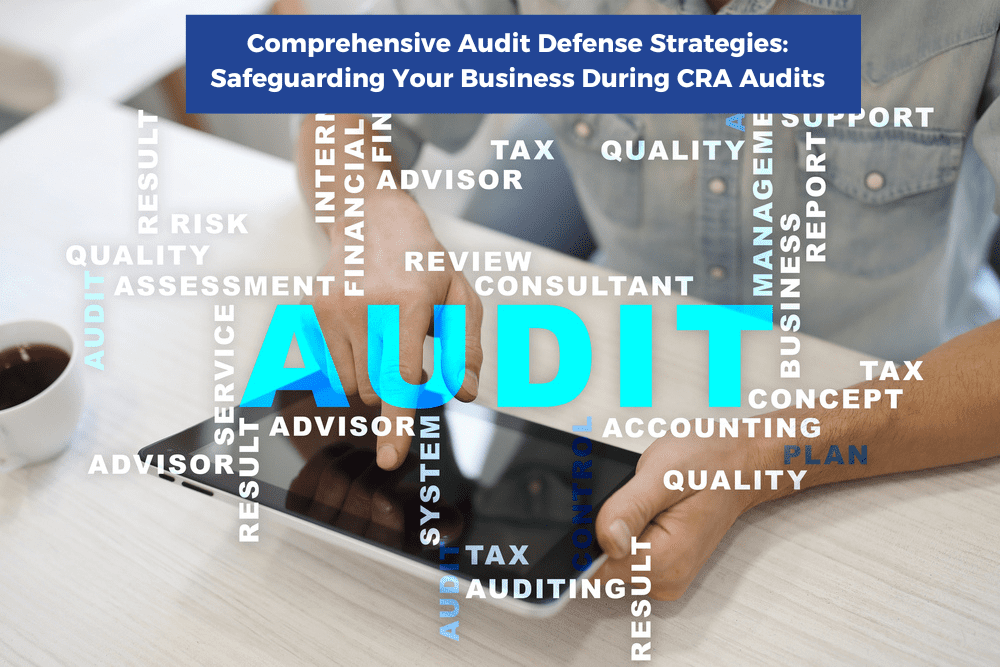
Facing a Canada Revenue Agency (CRA) audit can be a daunting experience for any business. However, with well-planned audit defense strategies, it is possible to manage the process effectively and protect your business interests. This blog explores key tactics to safeguard your business during CRA audits, ensuring compliance and minimal disruption.
Understanding CRA Audits
CRA audits serve a pivotal role in ensuring tax compliance and accurate reporting. These audits are not conducted randomly but are generally triggered by discrepancies in tax filings, such as inconsistencies in reported income or expenses. For instance, if your business frequently claims unusually high expenses compared to others in your industry, this might warrant closer scrutiny by the CRA. Additionally, compliance regulations like the Goods and Services Tax (GST) collection requirements are strict, emphasizing the need for businesses to maintain diligent records. Understanding these triggers can help businesses preemptively rectify potential issues, minimizing the likelihood of an audit. Familiarizing yourself with theGST regulations can also provide insights into common audit triggers and how to avoid them.
Another factor that may initiate an audit is the scope of the transaction. In large financial dealings, especially those crossing international borders, the CRA may step in to ensure compliance with Canadian tax laws. Businesses must understand these dynamics because an audit can have significant implications beyond discovering potential underpayments. Missteps can lead to penalties and interest charges, escalating financial risk. Therefore, understanding both the purpose and the potential triggers of a CRA audit is essential in fortifying your defense strategies.
Preparing for a CRA Audit
Effective preparation is foundational in defending against CRA audits. Organizing your financial documents meticulously is imperative, covering everything from receipts to banking transactions. Having these records in a systematic format, accessible when needed, not only simplifies potential audits but also facilitates efficient tax management. When a business anticipates an audit, the preparedness of their documentation can significantly influence the audit’s course. Apart from organizing records, familiarity with tax obligations, especially indirect taxes, is crucial. These obligations can be varied and complex, requiring adherence to specific reporting structures. A valuable tip is to reviewindirect taxes comprehensively to ensure no tax liability is overlooked.
The CRA encourages businesses to adopt self-review techniques to identify errors before an audit occurs. By implementing robust internal controls—a system designed to detect inconsistencies in financial reporting—companies can bolster their preparedness. This proactive approach not only limits exposure during audits but also enhances overall financial integrity. If your company specializes in dealing with complex tax situations, it can be beneficial to engage tax experts who have a deeper understanding of the CRA’s audit procedures. Their insight can prove invaluable, particularly when it comes to avoiding common pitfalls that might induce scrutiny from the CRA. Furthermore, staying up-to-date with tax training and consultancy services can keep your business abreast of any legislative changes that could affect your audit preparedness.
Such preparation goes beyond simply avoiding a negative audit outcome—it positions the business to operate more efficiently and transparently within the bounds of prevailing tax laws. Strategic planning and a thorough understanding of taxation policies can alleviate much of the stress associated with CRA audits. For Canadian enterprises, managing indirect tax risk helps align business practices with regulatory requirements, reducing the chances of sanctions and helping maintain smooth operations.
Key Audit Defense Strategies
Building a robust audit defense strategy involves several vital components. One integral factor is maintaining comprehensive and precise documentation. Every financial statement, tax return, and supplementary document should accurately reflect your business transactions. This documentation acts as the first line of defense when faced with a CRA audit. Each piece of data should be verifiable and easily accessible. Businesses are encouraged to utilize audit trails within their accounting software to track amendments and adjustments to financial statements, ensuring transparency and accountability.
Implementing stringent internal oversight mechanisms also plays a critical role in audit defense. These controls need to be tailored to your business’s size, complexity, and risk exposure and should regularly be evaluated and updated. Such controls might include reconciliation processes, validation procedures for tax returns, and regular audits facilitated by external partners to ensure objectivity and thoroughness. These strategies not only minimize audit risks but also protect your company against fraudulent activities. Partnering with aknowledgeable tax lawyer or tax professional can further empower your defenses with expert advisory, ensuring compliance and reducing exposure to potential legal challenges.
Finally, businesses should consider the strategic benefits of indirect tax management; indirect taxes can form a considerable part of a company’s tax liability, and hence effective management is critical. By understanding and managing your company’s VAT or GST obligations, as well as staying informed about local and international tax changes, can streamline your operations and audit defense simultaneously. With the advent of advanced data analytics, companies can enhance their strategic positioning, enabling precise forecasting, collection, and remittance of indirect taxes, as highlighted in the importance of indirect tax management as documented by industry leaders.
Communicating with CRA Officials
An essential component of a successful audit defense is maintaining open and effective communication with CRA auditors. When CRA audit representatives arrive for reviews, exhibiting transparency and cooperation can yield positive results. Businesses should prepare for the audit by having a designated point of contact to manage communications with the auditor. This representative should possess an in-depth understanding of the company’s financial and operational landscape, ensuring they can confidently answer any queries put forth by the CRA officials.
Proactive engagement with auditors is also important. This means promptly responding to information requests and providing thorough explanations about the company’s operations and financial dealings. By taking a proactive stance, businesses can demonstrate their commitment to compliance and transparency, potentially mitigating the audit’s intensity. Consistency and honesty in interactions are crucial, as misrepresentations can lead to legal ramifications and additional penalties. When queries arise that require more detailed examination, our team atJeremy Scott Tax Law recommends scheduling a follow-up meeting rather than responding on the fly. This strategy can provide more time to prepare accurate and comprehensive responses, which can enhance both the accuracy of the information shared and the efficiency of the audit process.
Handling Audit Findings
Post-audit, businesses must handle the findings with tact and precision. Understanding the specifics of filed assessments and being prepared to manage disputes or rectify errors is essential. Most times, the CRA will issue a Notice of Reassessment if adjustments are needed. Businesses should carefully review this notice to understand deviations from their filings and prepare to adjust incorrect figures. Adequate attention is necessary here, as rectifying seemingly minor errors can prevent substantial penalties or future audits.
In situations where the audit outcome is contentious, companies may choose to file objections. This legal recourse allows businesses to contest audit findings. The objection process involves presenting justified reasons and backed evidence disputing the CRA’s conclusions. Engage an experienced tax attorney to guide your company through this intricate landscape of tax dispute resolution. Maintaining diligenttax management practices can fortify your defense and support your claims with robust documentation and clearly articulated arguments.
Should these measures not resolve the situation, a Notice of Appeal to the Tax Court of Canada might be the requisite action. However, this process demands expert legal navigation and comprehensive documentation to support your case robustly. Proactive measures ensuring that financial discrepancies are minimized and that thorough records are kept can greatly reduce the likelihood of reaching this stage. Engaging in consistent, comprehensive audit strategies as outlined above will not only bolster day-to-day financial operations but will also ensure that when challenges arise, your business is well-equipped to face them with confidence.
Conclusion: Navigating CRA Audits with Confidence
By implementing comprehensive audit defense strategies, businesses can navigate CRA audits with confidence and minimal stress. Proactive preparation, understanding your rights, and maintaining open communication with CRA officials are vital to ensuring a smooth process. With these strategies, businesses can safeguard their operations and emerge stronger from the audit process.



